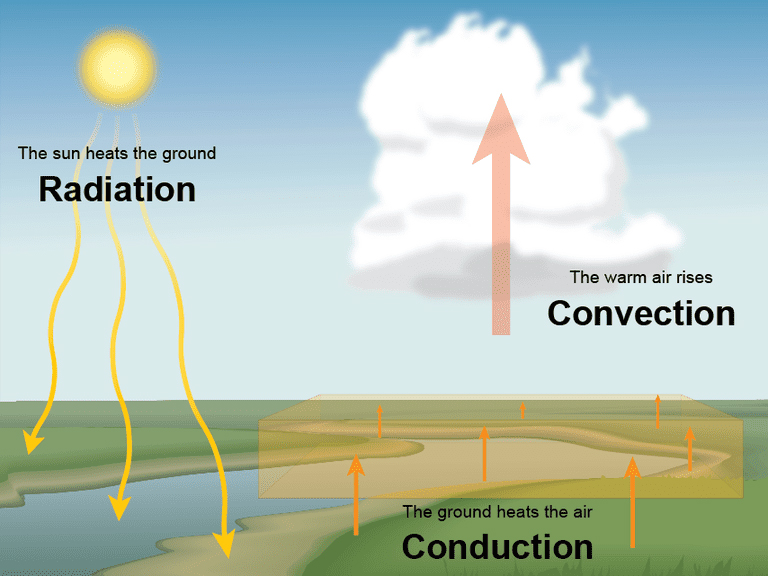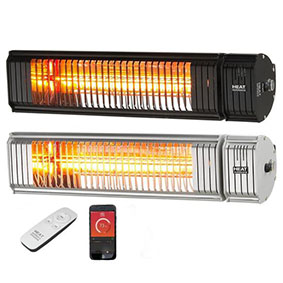Before we dive deeper into the specifics of infrared heat, let's start with an overview of the three different ways that heat can be transferred:

Radiation is exactly what infrared heat lamps use. This makes them ideal for outdoor spaces as the air in the vicinity will stay the same temperature, whilst people within the space will feel warmed. But it gets a little more complicated than this...
Infrared light is actually split into three separate categories, in accordance with the wavelength range. The longest wavelengths of infrared light are referred to as 'long infrared' or 'far infrared', then there's also a medium infrared, and short wave infrared. All three wavelengths are naturally occurring and have slightly different properties which means they are best used for separate applications.
The sun for example, emits short-wave infrared as this type of radiation contains the most energy. It makes sense with the sun being such a ginormous ball of energy that it would give off this wavelength. This radiation then hits earth, penetrating our atmosphere and warming the planet. This energy is then re-emitted as longwave infrared waves.
What's important to know is which type of wavelength best suits your outdoor heating requirements. They all have their advantages and disadvantages.
Watch the video for an explaination of the types of infrared light.


The absolute best choice for most people's outdoor heating needs is short-wave infrared heater as the lamp reaches full temperature almost immediately and is the hottest option. These lamps run up to 2,200 °C and have a radiating efficiency of 80%. This means that outdoor patio heaters using these short-wave lamps provide an instant and intense heat source, warming people directly and wasting very little energy in the process.
Practically speaking, on a windy day outdoors your shortwave infrared heater will heat you just as powerfully as if you were indoors with it switched on - air movement doesn't affect it.
The Shadow 2kW XT Heater pictured right is a superb short-wave infrared heater with ultra low glare technology. They can be wall mounted or attached to a stand to create a portable unit.
Next up we have our medium wave lamps which still boast a speedy start up time (usually under 30 seconds), but with a lower heat output of 900°C and reduced efficiency. Here, around 40% of heat is lost in heating the air as opposed to directly targeting people and this does in turn mean that on a windy day you will really struggle to get the same kind of warmth from these lamps. Carbon lamps typically provide medium wave heat.
Finally long-wave infrared heat runs much cooler at 300°C, takes around 5 minutes to warm up, and only 40% of the energy here is converted into heat. This means that around 60% is wasted heating the air. This type of lamp does have its uses in environments where no glass is allowed or indoor spaces where heating air wouldn't be a big waste of energy. The Shadow Noir range of heaters provide longwave infrared heat with zero light levels.
Ultimately there is no 'best' option for everybody. The heater that is best for you will vary according to what kind of space you're trying to heat, your budget and how much heat you want.
References:
Kavga, A., Pantelakis, S., Panidis, T. and Bontozoglou, V., 2008. INVESTIGATION OF THE POTENTIAL OF LONG WAVE RADIATION HEATING TO REDUCE ENERGY CONSUMPTION FOR GREENHOUSE HEATING. Acta Horticulturae, (801), pp.741-748.
Petráš, D., & Kalús, D. (2000). Effect of Thermal Comfort/Discomfort due to Infrared Heaters Installed at Workplaces in Industrial Buildings. Indoor and Built Environment, 9(3-4), 148-156. doi:10.1159/000057503
Kreith, F. and Black, W.Z., 1980. Basic heat transfer (p. 249). New York: Harper & Row.
Climate.ncsu.edu. 2021. Longwave and Shortwave Radiation | North Carolina Climate Office. [online] Available at: Radiation Types [Accessed 17 February 2021].
Kowalski, M. Hidden Object Detection and Recognition in Passive Terahertz and Mid-wavelength Infrared. J Infrared Milli Terahz Waves 40, 1074-1091 (2019). Passive Terahertz and Mid-wavelength Infrared